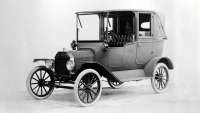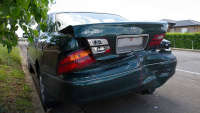There was a time, probably within your lifetime, when the idea of an SUV with two-wheel drive would have been as absurd as a vegetarian crocodile, a teetotaller pacifist bikie or an honest FIFA representative.
Such a thing would have no reason to exist, because it would be an object of derision and would sell like Liquorice Coke.
Back then, SUVs were made for young, hip 30-somethings who liked to splash along the beach at low tide to get to their favourite parasailing spot or to play oiled-up beach volley ball.
Real high-riding, big-tyred four-wheel drives were not made for life's ho-humdrum moments, like the school run or grocery schlepping. Or at least it didn't look like it from the advertisements.
Peddling tall, all-wheel-drive wagons for their rugged off-road capabilities might be the flimsiest pretext in marketing since doctor-endorsed cigarettes, but it hasn't stopped buyers, and Jeep is making a killing with it as we speak.
SUVs are like Taylor Swift, despite their humble country origins, they have become disturbingly ubiquitous. At least buyers of these big trucks have become self-aware and unashamed enough to accept the existence of two-wheel-drive SUVs, the cross-dressers of the car world.
The typical soft-roader SUV customer, and quite often it is a woman, and a mum, cares not for whether she can climb, or slowly descend down, a mountain of mud and is quite happy with a cheaper, front-wheel-drive variant. But would she be safer, and wiser, if she'd chosen an all-wheel drive SUV?
Getting a grip on safety
If you gaze at the convincing diagrams in brochures, showing you how you'll never, ever lose grip if you've got all-wheel-drive beneath you, it can seem like the only sane choice for anyone who lives in a country that does, after all, contain quite a few kilometres of unsealed road.
Out on the open road, where danger is just around the next corner, all-wheel drive can feel like a warm, comforting safety blanket.
Four driven wheels will only help you grip when you're accelerating
But do you really need it, and is it a silver bullet for maintaining traction, always? Well, logically, four driven wheels will only help you grip when you're accelerating. When you're off the throttle and slowing down, the added weight of extra differentials and driveshafts will add to your stopping distance, especially on low-grip surfaces (that extra weight isn't great for your fuel economy, either).
In some cases, all-wheel drive will help when cornering, as the system will react to slipping wheels and ensure maximum grip. Keep in mind, however, that modern stability-control systems can also do this in two-wheel-drive cars by gently applying braking force to slipping wheels.
And all-wheel drive is not infallible in low-grip situations. Depending on the system's capabilities, they can still be vulnerable on ice and snow. Part-time all-wheel drive is particularly susceptible, with the front-biased torque delivery sometimes leaving the front wheels spinning and the rears underpowered.
The reactive nature of part-time systems means that you need to lose traction momentarily before the system will kick in, unless you engage all-wheel drive manually. These manual-lock modes are often automatically disengaged above 50km/h, however, so their use is limited.
Tyres and ground clearance
With suitable tyres fitted, some very ordinary two-wheel-drive cars have conquered some extraordinarily harsh territory. The tiny and dearly beloved 1960s Mini Cooper won the Monte Carlo rally three times on the trot, overcoming rain, snow and ice along treacherous mountain roads with front-wheel drive.
Modern rally cars may be AWD grip monsters, but it's still possible to do the same routes with just two driven wheels, if you're game.
The rally-dominating Mini's front-drive setup aided traction in poor conditions because its driven wheels were pressed onto the road by the heavy engine. Most two-wheel-drive SUVs and crossovers are front-wheel drive, which helps prevent slipping under acceleration.
A notable exception is the Falcon-based Ford Territory, which is rear-wheel drive by default, which is partly why it's a much more enjoyable thing to drive.
The first impediment to proper off-road driving is ground clearance. Take a low-slung car on a high-peaked country road and you'll be destroying your underpinnings in no time. SUVs and crossovers tend to have a higher ride height, which helps with going outback, but all-wheel drive is still far from essential. Even fire trails don't necessarily require all-wheel drive; with modern stability systems and decent ride height, you'd be amazed at how far you can get.
Two wheels good, four wheels better?
All-wheel drive is a comforting inclusion on higher-spec, and more rugged, SUVs, but it's one that buyers are willing to go without. In fact, when it came time to replace the volume-selling Dualis, Nissan Australia found that AWD was barely of interest to buyers.
"We found that less than five per cent of Dualis sales were for the all-wheel drive model," spokesman Peter Fadeyev tells us.
"So when we were planning the release of the new Qashqai to replace the Dualis, we responded to consumer demand. It was clear that our customers wanted the Dualis for its space and features, not the all-wheel drive, so we made the decision to sell the Qashqai exclusively as a two-wheel-drive model."
Most soft-roaders are never going to test their approach angles on anything more stressful than a speed bump
In reality, only a few, thick-jumper-wearing people buy big 4WDs to head out into the wild blue yonder and spend a few distracting days getting bogged and then towing each other out again. Most soft-roaders are never going to test their approach angles on anything more stressful than a speed bump.
These days, SUVs are mainly about space, packaging, aesthetics and most of all, image. The traditional Aussie station wagon has been on the nose more than a Sydney taxi in summer, while a tough-looking truck is increasingly a city fashion accessory.
Two-wheel drive SUVs and crossovers are cheaper to buy and more fuel efficient, thanks to their lower weight. So, unless you regularly go skiing or you genuinely love snatch straps and tow bars, you shouldn't be ashamed to hide a front-drive car under your SUV's giant skirts.



.jpg)
.jpg)
.jpg)


.jpg)

.jpg)
 copy.jpg)


.jpg)
.jpg)





.jpg)
Comments